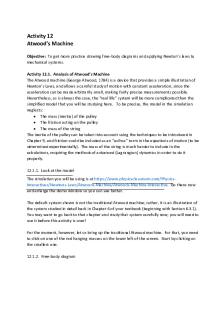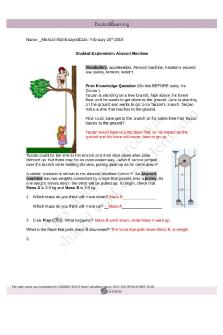The Atwood Machine - lab report PDF

| Title | The Atwood Machine - lab report |
|---|---|
| Author | Isaac Solano |
| Course | Physics |
| Institution | California State Polytechnic University Pomona |
| Pages | 2 |
| File Size | 83.6 KB |
| File Type | |
| Total Downloads | 100 |
| Total Views | 174 |
Summary
lab report...
Description
1 The Atwood Machine The Atwood Machine Isaac Solano Physics 1510L-16 02/26/2020 Introduction: In this lab we studied Newton’s 2nd Law through attempting to predict that the acceleration of a system is proportional to the net force acting on it. We used a pulley system to determine the downward acceleration of an object mass 1 and the upward acceleration of an object mass 2. Using this pulley and varying the two masses we will be able to graph multiple graphs such as net force versus acceleration as well as inverse acceleration versus total mass. Objective: The objective of this lab is to examine that the acceleration of a system is directly proportional to the net force acting on it and inversely proportional to its total mass. We also graphed the results of our experiments to determine how accurate it is. Furthermore, we will attempt to check predictions made on Newton’s 2nd Law. Apparatus: Computer, Laser-gate assembly, Lab pole, Atwood pulley, (2) Small plastic mass buckets, (2) Slotted mass sets, Small mass set. Procedure: Part A: The first step in this section is to set up the pulley and launch the “Rotational Motion” program. We will start with masses of 52 in one cup and 48 in another then measure their acceleration. Form there we will one gram from the cup with 48g to the 52g at a time and calculate the acceleration. Once this done 6-10 times, we will then input our data into the computers “Line Fit” program and graph our data as net force versus acceleration. Mass 1 (g) vs Mass 2 (g) Net Force (N) Acceleration (cm/ s 2 ) 52 g vs 48 g 39.2 (N) 29.53 cm/ s 2 53 g vs 47 g 58.8 (N) 49.55 cm/ s 2 54 g vs 46 g 78.4 (N) 64.00 cm/ s 2 55 g vs 45 g 98.0 (N) 77.47 cm/ s 2 56 g vs 44 g 117.6 (N) 93.29 cm/ s 2 57 g vs 43 g 137.2 (N) 96.23 cm/ s 2 58 g vs 42 g 156.8 (N) 129.10 cm/ s 2 Slope= 1.27 ± 0.1 y-int= 0.38 ± .8 Part B: For this part of the experiment we only have two steps. Our first step is to take data of our own design where the net force is constant, but the total mass is varying. After this step we will then plot and analyze our graph of inverse acceleration vs the total mass. Mass 1(g) vs Mass 2(g) Net Force (N) Acceleration (cm/ s 2 ) 52 g vs 48 g 39.2 (N) 34.92 (cm/ s 2 ) 50 g vs 46 g 39.2 (N) 36.75 (cm/ s 2 ) 48 g vs 44 g 39.2 (N) 38.98 (cm/ s 2 ) 56 g vs 52 g 39.2 (N) 33.74 (cm/ s 2 ) 60 g vs 56 g 39.2 (N) 31.81 (cm/ s 2 ) 64 g vs 60 g 39.2 (N) 29.27 (cm/ s 2 ) y-int= 0.006 ± 0.001 Slope= 0.000222 ± 0.00001
2 The Atwood Machine Part C: In part C we will make a theoretical prediction where we will obtain a specific acceleration of 60 cm/ s 2 . Once this is found we will test our prediction then determine if our prediction is supported by the experimental result. Mass 1 (g) vs Mass 2 (g) Net Force (N) Acceleration (cm/ s 2 ) 54 g vs 46 g 78.4 N 60.7 cm/ s 2 Data analysis: Our data in part A was accurate and our line of best fit in the graphing program was lineal. The acceleration of our values continually increased as we shifted a gram from one cup to the other. In part B, we realized that in order to maintain a constant net force we had to have a constant total mass as well. Therefore, we kept a total mass equal to four by adding and subtracting four grams from both masses. Our graph was made with inverse acceleration versus total mass. This graph had a line of best fit that was lineal, and our acceleration increased the lower our two masses were. In part C, we determined from our data in part A that a weight difference of 54 g vs. 46 g was very close to reaching 60.0 cm/ s 2 therefore, we figured that if we retested this mass, we can reach the desired acceleration. Physics Principles: The principles used in this lab were Newton’s Laws and graphing. Specifically, Newton’s Second Law was used through F=m(a) within our experiment. We used this law to be able to graph multiple parts of our experiments. Furthermore, this law was used in the computer program to find acceleration. Uncertainties are used in every lab and is used to help determine the best answer for both slope and y-intercept in this lab. Conclusions: Throughout this lab I didn’t notice many discrepancies within the graphs I made and the equations. A discrepancy that I did find were that on multiple occasions the net force I found did not equal the one found using F=m(a). In my lab we did not use equations 5 and 6 however I believe that my graphs would agree with the predictions of this theories. Equations 5 and 6 are used to include the effects of pulley inertia and friction. Therefore, these equations would be necessary if the inertia and friction must be included such as finding force, however, it would be unnecessary when this would not be necessary such as finding accelerations. In part A and part B it is necessary to find a range in which acceleration varies by a large amount because to find a best fit line we would need a variety of points. I think it is unreasonable to think that frictional force in the pulley will be the same through all runs because the force can vary depending on the mass. Complications that can arise from the laser-gate tabs on the pulleys is detection of a hand which would affect the costs. Furthermore, the masses could fall of the pulley and the laser gate will detect an incorrect acceleration. Recommendations: I would recommend applying a device that releases the masses on the pulley automatically so that the acceleration could be found more accurately and lead to less mistakes in the lab....
Similar Free PDFs

The Atwood Machine - lab report
- 2 Pages

Atwood Machine - Lab report.
- 2 Pages

Lab( The Atwood Machine )
- 7 Pages

Lab 4 - the atwood machine
- 9 Pages

atwood lab- lab report
- 4 Pages

Lab Report 2- Atwood Lab
- 6 Pages

LAB Report Lathe Machine
- 13 Pages

Atwood LAB
- 5 Pages

Lab 12 - Atwoods Machine
- 6 Pages

Atwood\'s Machine Online Lab
- 4 Pages

Machine Learning LAB Manual
- 66 Pages

Lab Manual Machine Learning
- 27 Pages
Popular Institutions
- Tinajero National High School - Annex
- Politeknik Caltex Riau
- Yokohama City University
- SGT University
- University of Al-Qadisiyah
- Divine Word College of Vigan
- Techniek College Rotterdam
- Universidade de Santiago
- Universiti Teknologi MARA Cawangan Johor Kampus Pasir Gudang
- Poltekkes Kemenkes Yogyakarta
- Baguio City National High School
- Colegio san marcos
- preparatoria uno
- Centro de Bachillerato Tecnológico Industrial y de Servicios No. 107
- Dalian Maritime University
- Quang Trung Secondary School
- Colegio Tecnológico en Informática
- Corporación Regional de Educación Superior
- Grupo CEDVA
- Dar Al Uloom University
- Centro de Estudios Preuniversitarios de la Universidad Nacional de Ingeniería
- 上智大学
- Aakash International School, Nuna Majara
- San Felipe Neri Catholic School
- Kang Chiao International School - New Taipei City
- Misamis Occidental National High School
- Institución Educativa Escuela Normal Juan Ladrilleros
- Kolehiyo ng Pantukan
- Batanes State College
- Instituto Continental
- Sekolah Menengah Kejuruan Kesehatan Kaltara (Tarakan)
- Colegio de La Inmaculada Concepcion - Cebu



